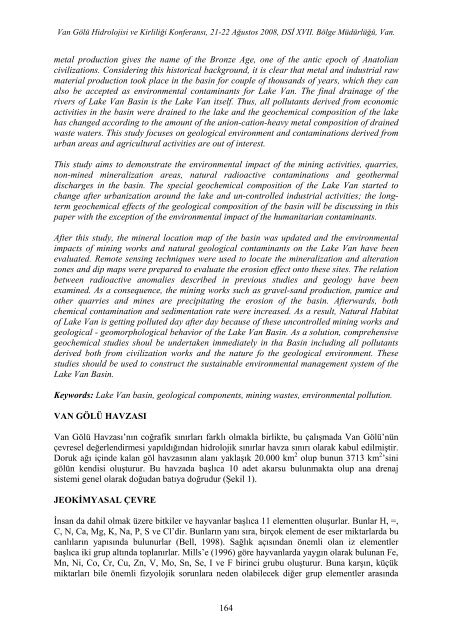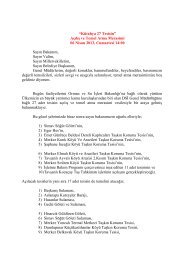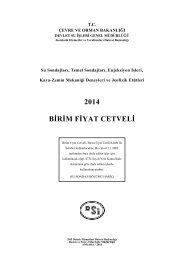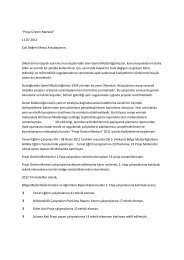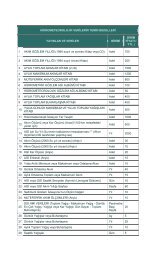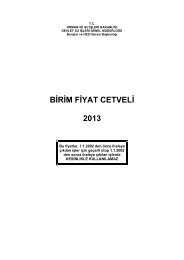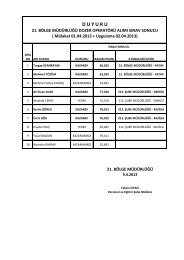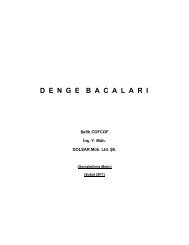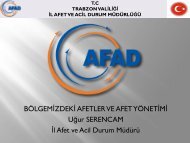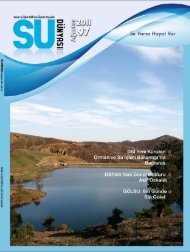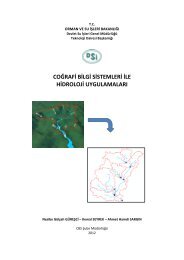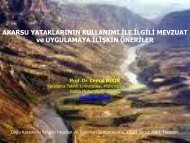van gölü hidrolojisi ve kirliliÄi konferansı bildiri kitabı
van gölü hidrolojisi ve kirliliÄi konferansı bildiri kitabı
van gölü hidrolojisi ve kirliliÄi konferansı bildiri kitabı
Create successful ePaper yourself
Turn your PDF publications into a flip-book with our unique Google optimized e-Paper software.
Van Gölü Hidrolojisi <strong>ve</strong> Kirliliği Konferansı, 21-22 Ağustos 2008, DSİ XVII. Bölge Müdürlüğü, Van.metal production gi<strong>ve</strong>s the name of the Bronze Age, one of the antic epoch of Anatoliancivilizations. Considering this historical background, it is clear that metal and industrial rawmaterial production took place in the basin for couple of thousands of years, which they canalso be accepted as environmental contaminants for Lake Van. The final drainage of theri<strong>ve</strong>rs of Lake Van Basin is the Lake Van itself. Thus, all pollutants deri<strong>ve</strong>d from economicactivities in the basin were drained to the lake and the geochemical composition of the lakehas changed according to the amount of the anion-cation-heavy metal composition of drainedwaste waters. This study focuses on geological environment and contaminations deri<strong>ve</strong>d fromurban areas and agricultural activities are out of interest.This study aims to demonstrate the environmental impact of the mining activities, quarries,non-mined mineralization areas, natural radioacti<strong>ve</strong> contaminations and geothermaldischarges in the basin. The special geochemical composition of the Lake Van started tochange after urbanization around the lake and un-controlled industrial activities; the longtermgeochemical effects of the geological composition of the basin will be discussing in thispaper with the exception of the environmental impact of the humanitarian contaminants.After this study, the mineral location map of the basin was updated and the environmentalimpacts of mining works and natural geological contaminants on the Lake Van ha<strong>ve</strong> beenevaluated. Remote sensing techniques were used to locate the mineralization and alterationzones and dip maps were prepared to evaluate the erosion effect onto these sites. The relationbetween radioacti<strong>ve</strong> anomalies described in previous studies and geology ha<strong>ve</strong> beenexamined. As a consequence, the mining works such as gra<strong>ve</strong>l-sand production, pumice andother quarries and mines are precipitating the erosion of the basin. Afterwards, bothchemical contamination and sedimentation rate were increased. As a result, Natural Habitatof Lake Van is getting polluted day after day because of these uncontrolled mining works andgeological - geomorphological behavior of the Lake Van Basin. As a solution, comprehensi<strong>ve</strong>geochemical studies shoul be undertaken immediately in tha Basin including all pollutantsderi<strong>ve</strong>d both from civilization works and the nature fo the geological environment. Thesestudies should be used to construct the sustainable environmental management system of theLake Van Basin.Keywords: Lake Van basin, geological components, mining wastes, environmental pollution.VAN GÖLÜ HAVZASIVan Gölü Havzası’nın coğrafik sınırları farklı olmakla birlikte, bu çalışmada Van Gölü’nünçevresel değerlendirmesi yapıldığından hidrolojik sınırlar havza sınırı olarak kabul edilmiştir.Doruk ağı içinde kalan göl havzasının alanı yaklaşık 20.000 km 2 olup bunun 3713 km 2 ’sinigölün kendisi oluşturur. Bu havzada başlıca 10 adet akarsu bulunmakta olup ana drenajsistemi genel olarak doğudan batıya doğrudur (Şekil 1).JEOKİMYASAL ÇEVREİnsan da dahil olmak üzere bitkiler <strong>ve</strong> hay<strong>van</strong>lar başlıca 11 elementten oluşurlar. Bunlar H, =,C, N, Ca, Mg, K, Na, P, S <strong>ve</strong> Cl’dir. Bunların yanı sıra, birçok element de eser miktarlarda bucanlıların yapısında bulunurlar (Bell, 1998). Sağlık açısından önemli olan iz elementlerbaşlıca iki grup altında toplanırlar. Mills’e (1996) göre hay<strong>van</strong>larda yaygın olarak bulunan Fe,Mn, Ni, Co, Cr, Cu, Zn, V, Mo, Sn, Se, I <strong>ve</strong> F birinci grubu oluşturur. Buna karşın, küçükmiktarları bile önemli fizyolojik sorunlara neden olabilecek diğer grup elementler arasında164


